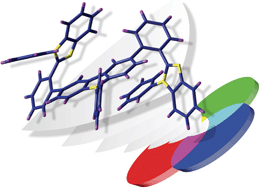Manipulation of connecting topology in carbazole/benzimidazole universal bipolar host materials for RGB and White PhOLEDs†
Abstract
Two isomeric bipolar molecules (o-CPhBzIm and m-CPhBzIm) composed of a carbazole as central donor and two benzimidazoles as peripheral acceptors bridged by phenylene groups with different connection topology are reported. The molecular π-conjugation is only limitedly extended with a meta-conjugation in m-CPhBzIm and a highly twisted conformation in o-CPhBzIm, giving blue-shifted UV-vis and PL spectra and higher triplet energies as compared to those of their para-counterpart (p-CPhBzIm). o-CPhBzIm exhibited interesting photophysical and electrochemical behaviors due to significant intramolecular donor–acceptor interactions, which were confirmed by the results of theoretical analyses and the observation of its X-ray structure. The physical properties are subtly governed by the linkage topology, giving o-CPhBzIm and m-CPhBzIm promising properties for serving as universal bipolar PhOLEDs with a common device configuration. Especially, the high triplet energies of o-CPhBzIm and m-CPhBzIm assure efficient confinement of blue phosphor emission, rendering the realizations of high efficiency blue and white PhOLEDs feasible. Monochromatic low roll-off PhOLEDs using m-CPhBzIm as universal host gave high efficiencies of 16.7% for red, 21.4% for green, 11.9% for blue, and 19.3% for yellow. PhOLEDs hosted by o-CPhBzIm performed with excellent efficiencies of 19.4% for red, 18.9% for green, 15.6% for blue, and 14.8% for yellow. In addition, three-color-based single-host WOLEDs hosted by o-CPhBzIm with high efficiency (18.5%, 32.6 cd A−1, 34.1 lm W−1) and CRI (up to 79) were successfully achieved.


 Please wait while we load your content...
Please wait while we load your content...